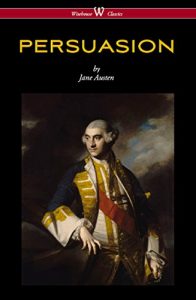PERSUASION is Jane Austen's last completed novel, published posthumously. She began it soon after she had finished Emma and completed it in August 1816. Persuasion was published in December 1817, but is dated 1818. The author died earlier in 1817. As the Napoleonic Wars come to an end in 1814, Admirals and Captains of the Royal Navy are put ashore, their work done. Anne Elliot meets Captain Frederick Wentworth after seven years, by the chance of his sister and brother-in-law renting her father's estate, while she stays for a few months with her married sister, living nearby. They fell in love the first time, but she broke off the engagement.
Besides the theme of persuasion, the novel evokes other topics, with which Austen was familiar: The Royal Navy, in which two of Jane Austen's brothers rose to the rank of admiral; and the superficial social life of Bath. It is portrayed extensively and serves as a setting for the second half of Persuasion. In many respects, Persuasion marks a break with Austen's previous works, both in the more biting, even irritable satire directed at some of the novel's characters and in the regretful, resigned outlook of its otherwise admirable heroine, Anne Elliot, in the first part of the story. Against this is set the energy and appeal of the Royal Navy, which symbolizes for Anne and the reader the possibility of a more outgoing, engaged, and fulfilling life, and it is this worldview which triumphs for the most part at the end of the novel.
Besides the theme of persuasion, the novel evokes other topics, with which Austen was familiar: The Royal Navy, in which two of Jane Austen's brothers rose to the rank of admiral; and the superficial social life of Bath. It is portrayed extensively and serves as a setting for the second half of Persuasion. In many respects, Persuasion marks a break with Austen's previous works, both in the more biting, even irritable satire directed at some of the novel's characters and in the regretful, resigned outlook of its otherwise admirable heroine, Anne Elliot, in the first part of the story. Against this is set the energy and appeal of the Royal Navy, which symbolizes for Anne and the reader the possibility of a more outgoing, engaged, and fulfilling life, and it is this worldview which triumphs for the most part at the end of the novel.






